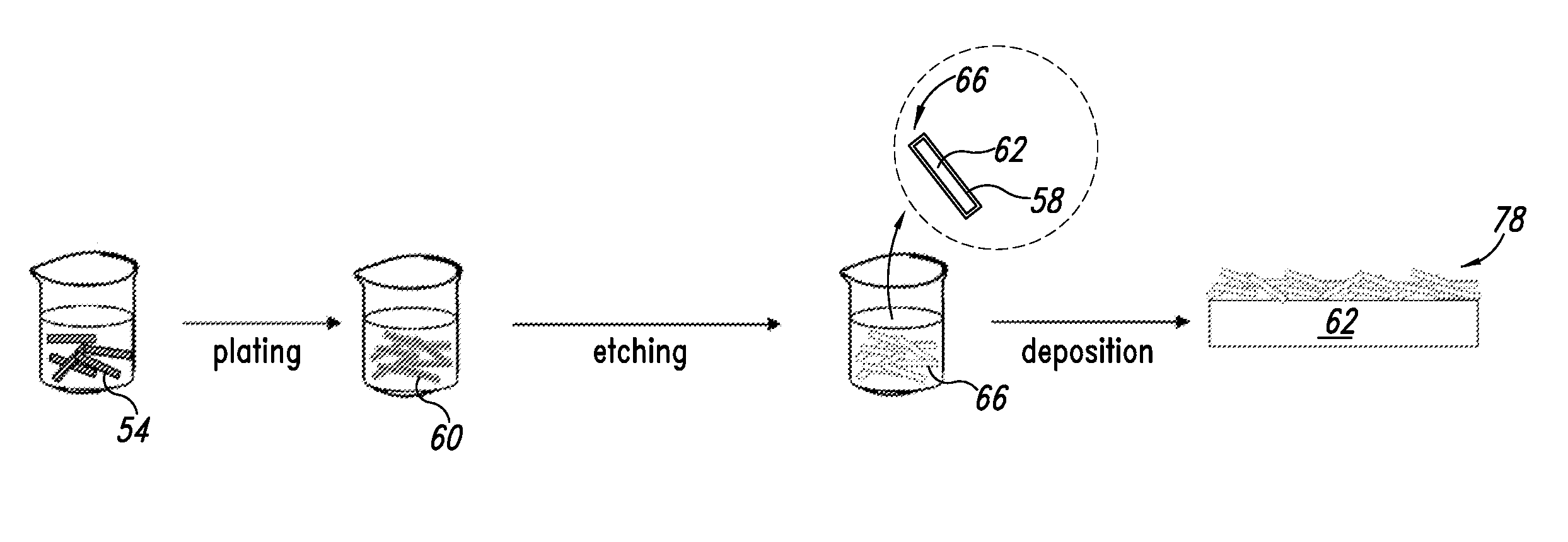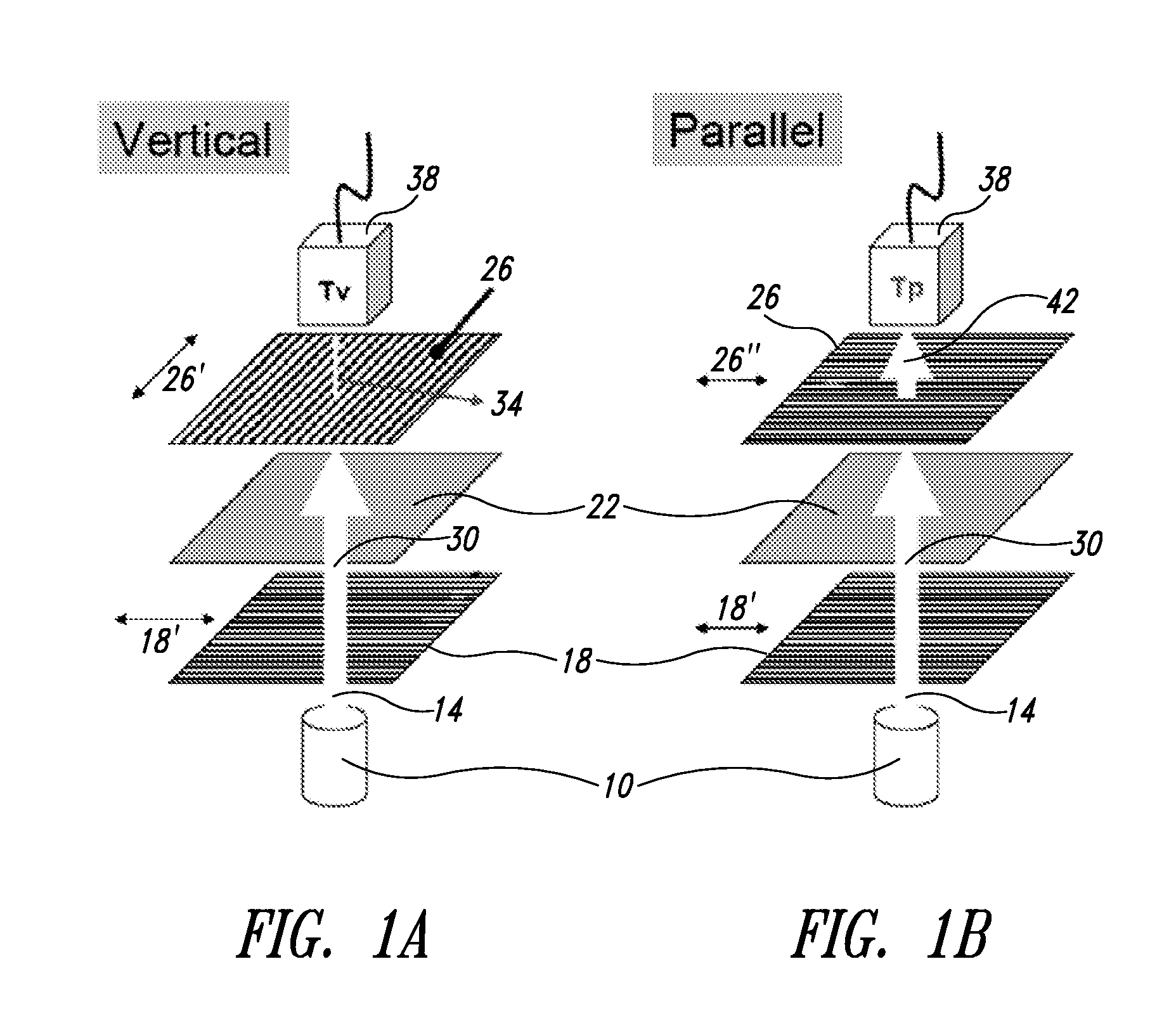High contrast transparent conductors and methods of forming the same
a transparent conductor, high contrast technology, applied in the field of high contrast transparent conductors, can solve the problems of lack of true black, loss of subtle details, depolarization of light, etc., and achieve the effect of enhancing the contrast ratio of conductive films and high contrast ratio
- Summary
- Abstract
- Description
- Claims
- Application Information
AI Technical Summary
Benefits of technology
Problems solved by technology
Method used
Image
Examples
example 1
Synthesis of Silver Nanowires
[0119]Silver nanowires were synthesized by a reduction of silver nitrate dissolved in ethylene glycol in the presence of poly(vinyl pyrrolidone) (PVP). The method was described in, e.g. Y. Sun, B. Gates, B. Mayers, & Y. Xia, “Crystalline silver nanowires by soft solution processing”, Nanolett, (2002), 2(2) 165-168. Uniform silver nanowires can be selectively isolated by centrifugation or other known methods.
[0120]Alternatively, uniform silver nanowires can be synthesized directly by the addition of a suitable ionic additive (e.g., tetrabutylammonium chloride) to the above reaction mixture. The silver nanowires thus produced can be used directly without a separate step of size-selection. This synthesis is described in more detail in U.S. Provisional Application No. 60 / 815,627, in the name of Cambrios Technologies Corporation, the assignee of the present application, which application is incorporated herein in it entirety.
[0121]In the following examples, s...
example 2
Preparation of Nanowire-Based Conductive Films
[0122]The nanowires can be formulated into an ink composition prior to deposition and optional orientation on a substrate.
[0123]A typical ink composition comprises, by weight, from 0.0025% to 0.1% surfactant (e.g., a preferred range is from 0.0025% to 0.05% for Zonyl® FSO-100), from 0.02% to 4% viscosity modifier (e.g., a preferred range is 0.02% to 0.5% for hydroxypropylmethylcellulose or HPMC), from 94.5% to 99.0% solvent and from 0.05% to 1.4% metal nanowires. Representative examples of suitable surfactants include Zonyl® FSN, Zonyl® FSO, Zonyl® FSH, Triton (x100, x114, x45), Dynol (604, 607), n-Dodecyl b-D-maltoside and Novek. Examples of suitable viscosity modifiers include hydroxypropyl methyl cellulose (HPMC), methyl cellulose, xanthan gum, polyvinyl alcohol, carboxy methyl cellulose, hydroxy ethyl cellulose. Examples of suitable solvents include water and isopropanol.
[0124]The ink composition can be prepared based on a desired co...
example 3
Evaluation of Optical and Electrical Properties of Transparent Conductors
[0130]The transparent conductors prepared according to the methods described herein were evaluated to establish their optical and electrical properties.
[0131]The light transmission data were obtained according to the methodology in ASTM D1003. Haze was measured using a BYK Gardner Hazegard Plus. Unless specified otherwise, the light transmission and haze are measured in the presence of a glass substrate. The surface resistivity was measured using a Fluke 175 True RMS Multimeter or contactless resistance meter, Delcom model 717B conductance monitor.
[0132]The interconnectivity of the nanowires and an areal coverage of the substrate can also be observed under an optical or scanning electron microscope.
PUM
| Property | Measurement | Unit |
|---|---|---|
| haze | aaaaa | aaaaa |
| transparent | aaaaa | aaaaa |
| viscosity | aaaaa | aaaaa |
Abstract
Description
Claims
Application Information
 Login to View More
Login to View More - R&D
- Intellectual Property
- Life Sciences
- Materials
- Tech Scout
- Unparalleled Data Quality
- Higher Quality Content
- 60% Fewer Hallucinations
Browse by: Latest US Patents, China's latest patents, Technical Efficacy Thesaurus, Application Domain, Technology Topic, Popular Technical Reports.
© 2025 PatSnap. All rights reserved.Legal|Privacy policy|Modern Slavery Act Transparency Statement|Sitemap|About US| Contact US: help@patsnap.com



